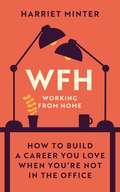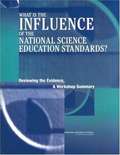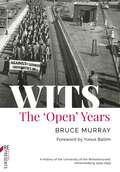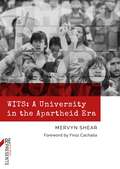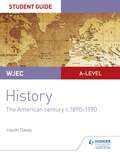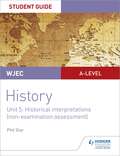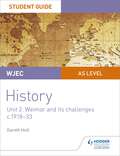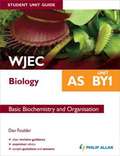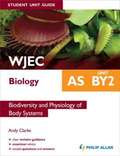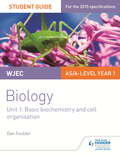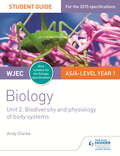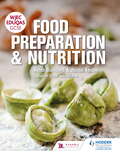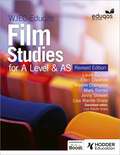- Table View
- List View
WFH (Working From Home): How to build a career you love when you're not in the office
by Harriet MinterThe no bullsh*t guide to getting your work and life on track in the new flexible workplace.Virtually every industry is making lasting changes that will open doors to a more flexible working week. So how do we adjust, thrive and excel in an environment where glitchy daily video conferences are the norm?By turns fierce, funny and highly practical, Harriet Minter will show you the skills to be effective and creative during the day-to-day. Harriet breaks down how to be an inspiring and energising manager (either remotely or to a flexibly working team), how to create and thrive in a high-trust culture (on a small and large scale) and most importantly how to achieve your ambition and propel your career forwards.Packed full of hard-won tricks, tips and tools, Harriet Minter draws on her own experience as a careers coach and adviser to companies on their flexible working culture to help you bring your best self to work - from your living room.(P)2021 Quercus Editions Limited
WFH (Working From Home): How to build a career you love when you’re not in the office
by Harriet MinterThe no bullsh*t guide to getting your work and life on track in the new flexible workplace.Virtually every industry is making lasting changes that will open doors to a more flexible working week. So how do we adjust, thrive and excel in an environment where glitchy daily video conferences are the norm?By turns fierce, funny and highly practical, Harriet Minter will show you the skills to be effective and creative during the day-to-day. Harriet breaks down how to be an inspiring and energising manager (either remotely or to a flexibly working team), how to create and thrive in a high-trust culture (on a small and large scale) and most importantly how to achieve your ambition and propel your career forwards.Packed full of hard-won tricks, tips and tools, Harriet Minter draws on her own experience as a careers coach and adviser to companies on their flexible working culture to help you bring your best self to work - from your living room.
WHAT IS THE INFLUENCE OF THE NATIONAL SCIENCE EDUCATION STANDARDS?: Reviewing the Evidence, A Workshop Summary
by Karen S. HollwegThe Influence of the National Science Education Standards
WHOLE: What Teachers Need to Help Students Thrive
by Rex Miller Bill Latham Kevin Baird Michelle KinderA shocking statistic in education reveals that 70% of K-12 teachers work under chronic stress. This revolutionary new book explains how removing stress from the classroom holds the key to improving education. The book also explains what administrators, teachers, parents, and communities can do to help accomplish a stress-free classroom. For years, the expert voices said “disengagement” was the crucial issue behind poor educational environments and results. Naturally, only massive reform could fix it. But what if the enormous restructuring and expenditures attacked the wrong problem? MindShift, an organization that reframes tired and clogged conversations, pushed the old conclusions off the table and started fresh. They gathered diverse leaders in education, leadership, neuroscience, architecture, and wellness in working forums around the nation. These pivotal meetings produced WHOLE, a game-changing approach to education. This book captures the story and details of how the system can be remade for real and lasting benefits to everyone. With the authors’ expertise, the book exposes the exhausted and antiquated thinking that led to the present crisis. But, WHOLE also proposes a new era of disruptive change that can produce happier, healthier, and more successful education for the 21st century. The book introduces the outliers, tells the stories, and presents the roadmaps to: Why teachers should be seen as high-performance athletes, requiring time for recovery and preparation How schools can become “field hospitals,” combining learning with healing Why space matters, how redesigning and refurnishing schools can eliminate stress and produce learning environments that are more open and inviting Ways to properly integrate schools within communities, building honest relationships, increasing social capital, and achieving transparency that increases success Packed with real-life examples, new research, and solutions that you can introduce to your own schools, students, and communities, WHOLE shows us how to move schools from the age of stress and insecurity to an age of true educational flourishing.
WITS: A History of the University of the Witwatersrand, Johannesburg 1939-1959
by Bruce MurrayIn the period between the outbreak of World War II in 1939 and the enactment of university apartheid by the Nationalist Government in 1959, the University of the Witwatersrand, Johannesburg (Wits) developed as an ‘open university’, admitting students of all races. This, the second volume of the history of Wits by historian Bruce Murray, has as its central theme the process by which Wits became ‘open’, the compromises this process entailed, and the defence the University mounted to preserve its ‘open’ status in the face of the challenges posed by the Nationalist Government.The University’s institutional autonomy is highlighted by Yunus Ballim in his preface to the centenary edition of WITS: The ‘Open’ Years. He writes: ‘The emerging posture of a university willing to rise in defence of academic freedom was important because this was to become infused into the institutional culture of Wits.’The book looks at the University’s role in South Africa’s war effort, its contribution to the education of ex-volunteers after the war, its leading role in training job-seeking professionals required by a rapidly expanding economy, and the rise of research and postgraduate study. Students feature prominently through their political activities, the flourishing of a student intelligentsia, the heyday of the Remember and Give (Rag) parade, rugby intervarsity, and the stunning success of Wits sportsmen and women. WITS: The ‘Open’ Years paints a vivid picture of the range of personalities who enlivened the campus – among them some well-known figures in the new South Africa.The book includes chapters by Alf Stadler, who was Professor of Political Studies at Wits and the author of The Political Economy of Modern South Africa, and Jonty Winch, former Sports Officer at Wits and the author of Wits Sport.
WITS: A History of the University of the Witwatersrand, Johannesburg, and its Precursors 1896-1939
by Bruce MurrayWITS: The Early Years is a history of the University up to 1939. First established in 1922, the University of the Witwatersrand, Johannesburg developed out of the South African School of Mines in Kimberley circa 1896. Examining the historical foundations, the struggle to establish a university in Johannesburg, and the progress of the University in the two decades prior to World War II, historian Bruce Murray captures the quality and texture of life in the early years of Wits University and the personalities who enlivened it and contributed to its growth.Particular attention is given to the wider issues and the challenges which faced Wits in its formative years. The book examines the role Wits came to occupy as a major centre of liberal thought and criticism in South Africa, its contribution to the development of the professions of the country, the relationship of its research to the wider society, and its attempts to grapple with a range of peculiarly South African problems, such as the admission of black students to the University and the relations of English- and Afrikaans-speaking white students within it.This edition of WITS: The Early Years is republished in the University’s centenary year with a preface by Keith Breckenridge, who writes, ‘In the republication of Murray’s two volume history of Wits, readers have an opportunity to explore the often dramatic and contested story of this university … Murray produced an intimate, almost scandalous intellectual history of the institution that served as his home for practically half a century.’
WITS: A University in the Apartheid Era
by Mervyn ShearWhen the National Government assumed power in 1948, one of the earliest moves was to introduce segregated education. Its threats to restrict the admission of black students into the four ‘open universities’ galvanised the staff and students of those institutions to oppose any attempt to interfere with their autonomy and freedom to decide who should be admitted. In subsequent years, as the regime adopted increasingly oppressive measures to prop up the apartheid state, opposition on the campuses, and in the country, increased and burgeoned into a Mass Democratic Movement intent on making the country ungovernable. Protest escalated through successive states of emergency and clashes with police on campus became regular events. Residences were raided, student leaders were harassed by security police and many students and some staff were detained for lengthy periods without recourse to the courts. First published in 1996, WITS: A University in the Apartheid Era by Mervyn Shear tells the story of how the University of the Witwatersrand (Wits) adapted to the political and social developments in South Africa under apartheid. This new edition is published in the University’s centenary year with a preface by Firoz Cachalia, one of Wits’ student leaders in the 1980s. It serves as an invaluable historical resource on questions about the relationship between the University and the state, and on understanding the University’s place and identity in a constitutional democracy.
WJEC A-level History Student Guide Unit 3: The American century c.1890-1990
by Haydn DaveyExam board: WJECLevel: AS/A-levelSubject: HistoryFirst teaching: September 2015First exams: Summer 2016 (AS); Summer 2017 (A-level)Build, reinforce and revise the historical knowledge and exam skills required for WJEC AS/A-level History.Matched to the 2016 specification for Wales, this study guide contains clear content summaries and annotated sample answers to exam questions.- Concisely covers the key issues and content in the specification, breaking the Unit down into manageable chunks- Consolidates understanding with regular knowledge-check questions, plus useful tips- Builds the analytical and evaluative skills that students need to succeed in AS/A-level History- Improves students' exam technique, providing sample student answers to past paper questions, with commentary to explain the number of marks awarded- Helps students to learn the content throughout the course, study independently and revise for their exams
WJEC A-level History Student Guide Unit 4: Nazi Germany Epub
by Gareth HoltExam board: WJECLevel: AS/A-levelSubject: HistoryFirst teaching: September 2015First exams: Summer 2016 (AS); Summer 2017 (A-level)Build, reinforce and revise the historical knowledge and exam skills required for WJEC AS/A-level History.Matched to the 2016 specification for Wales, this study guide contains clear content summaries and annotated sample answers to exam questions.- Concisely covers the key issues and content in the specification, breaking the Unit down into manageable chunks- Consolidates understanding with regular knowledge-check questions, plus useful tips- Builds the analytical and evaluative skills that students need to succeed in AS/A-level History- Improves students' exam technique, providing sample student answers to past paper questions, with commentary to explain the number of marks awarded- Helps students to learn the content throughout the course, study independently and revise for their exams
WJEC A-level History Student Guide Unit 4: Nazi Germany c.1933-1945
by Gareth HoltExam board: WJECLevel: AS/A-levelSubject: HistoryFirst teaching: September 2015First exams: Summer 2016 (AS); Summer 2017 (A-level)Build, reinforce and revise the historical knowledge and exam skills required for WJEC AS/A-level History.Matched to the 2016 specification for Wales, this study guide contains clear content summaries and annotated sample answers to exam questions.- Concisely covers the key issues and content in the specification, breaking the Unit down into manageable chunks- Consolidates understanding with regular knowledge-check questions, plus useful tips- Builds the analytical and evaluative skills that students need to succeed in AS/A-level History- Improves students' exam technique, providing sample student answers to past paper questions, with commentary to explain the number of marks awarded- Helps students to learn the content throughout the course, study independently and revise for their exams
WJEC A-level History Student Guide Unit 4: Nazi Germany c.1933-1945
by Gareth HoltExam board: WJECLevel: AS/A-levelSubject: HistoryFirst teaching: September 2015First exams: Summer 2016 (AS); Summer 2017 (A-level)Build, reinforce and revise the historical knowledge and exam skills required for WJEC AS/A-level History.Matched to the 2016 specification for Wales, this study guide contains clear content summaries and annotated sample answers to exam questions.- Concisely covers the key issues and content in the specification, breaking the Unit down into manageable chunks- Consolidates understanding with regular knowledge-check questions, plus useful tips- Builds the analytical and evaluative skills that students need to succeed in AS/A-level History- Improves students' exam technique, providing sample student answers to past paper questions, with commentary to explain the number of marks awarded- Helps students to learn the content throughout the course, study independently and revise for their exams
WJEC A-level History Student Guide Unit 5: Historical Interpretations (non-examination assessment)
by Phil StarExam board: WJECLevel: AS/A-levelSubject: HistoryFirst teaching: September 2015First exams: Summer 2016 (AS); Summer 2017 (A-level)Maximise your chance of coursework success with this step-by-step guide to the WJEC A-level History NEA.- Explains how to understand, approach and successfully answer the question/essay title, with tips to highlight important information and common pitfalls- Develops students' skills in analysing and evaluating primary source material- Teaches students how to identify and test the validity of historical interpretations- Offers extensive advice on essay writing, including drafting an effective introduction and conclusion- Provides one complete example of the NEA with annotations/commentary that show how it could be improved- Keeps students on track as they complete activities that help to structure their progress
WJEC A-level History Student Guide Unit 5: Historical Interpretations (non-examination assessment)
by Phil StarExam board: WJECLevel: AS/A-levelSubject: HistoryFirst teaching: September 2015First exams: Summer 2016 (AS); Summer 2017 (A-level)Maximise your chance of coursework success with this step-by-step guide to the WJEC A-level History NEA.- Explains how to understand, approach and successfully answer the question/essay title, with tips to highlight important information and common pitfalls- Develops students' skills in analysing and evaluating primary source material- Teaches students how to identify and test the validity of historical interpretations- Offers extensive advice on essay writing, including drafting an effective introduction and conclusion- Provides one complete example of the NEA with annotations/commentary that show how it could be improved- Keeps students on track as they complete activities that help to structure their progress
WJEC AS-level History Student Guide Unit 2: Weimar And Its Challenges Epub
by Gareth HoltExam board: WJECLevel: AS/A-levelSubject: HistoryFirst teaching: September 2015First exams: Summer 2016 (AS); Summer 2017 (A-level)Build, reinforce and revise the historical knowledge and exam skills required for WJEC AS/A-level History.Matched to the 2016 specification for Wales, this study guide contains clear content summaries and annotated sample answers to exam questions.- Concisely covers the key issues and content in the specification, breaking the Unit down into manageable chunks- Consolidates understanding with regular knowledge-check questions, plus useful tips- Builds the analytical and evaluative skills that students need to succeed in AS/A-level History- Improves students' exam technique, providing sample student answers to past paper questions, with commentary to explain the number of marks awarded- Helps students to learn the content throughout the course, study independently and revise for their exams
WJEC AS-level History Student Guide Unit 2: Weimar and its challenges c.1918-1933
by Gareth HoltExam board: WJECLevel: AS/A-levelSubject: HistoryFirst teaching: September 2015First exams: Summer 2016 (AS); Summer 2017 (A-level)Build, reinforce and revise the historical knowledge and exam skills required for WJEC AS/A-level History.Matched to the 2016 specification for Wales, this study guide contains clear content summaries and annotated sample answers to exam questions.- Concisely covers the key issues and content in the specification, breaking the Unit down into manageable chunks- Consolidates understanding with regular knowledge-check questions, plus useful tips- Builds the analytical and evaluative skills that students need to succeed in AS/A-level History- Improves students' exam technique, providing sample student answers to past paper questions, with commentary to explain the number of marks awarded- Helps students to learn the content throughout the course, study independently and revise for their exams
WJEC AS-level History Student Guide Unit 2: Weimar and its challenges c.1918-1933
by Gareth HoltExam board: WJECLevel: AS/A-levelSubject: HistoryFirst teaching: September 2015First exams: Summer 2016 (AS); Summer 2017 (A-level)Build, reinforce and revise the historical knowledge and exam skills required for WJEC AS/A-level History.Matched to the 2016 specification for Wales, this study guide contains clear content summaries and annotated sample answers to exam questions.- Concisely covers the key issues and content in the specification, breaking the Unit down into manageable chunks- Consolidates understanding with regular knowledge-check questions, plus useful tips- Builds the analytical and evaluative skills that students need to succeed in AS/A-level History- Improves students' exam technique, providing sample student answers to past paper questions, with commentary to explain the number of marks awarded- Helps students to learn the content throughout the course, study independently and revise for their exams
WJEC Biology AS Student Unit Guide: Unit BY1 eBook ePub Basic Biochemistry and organisation
by Dan Foulder Asuman Celen PollardPerfect for revision, these guides explain the unit requirements, summarise the content and include specimen questions with graded answers.Endorsed by WJEC, this full-colour Student Unit Guide provides ideal preparation for your unit exam:Feel confident you understand the unit: each guide comprehensively covers the unit content and includes topic summaries, knowledge check questions and a reference indexGet to grips with the exam requirements: the specific skills on which you will be tested are explored and explainedAnalyse exam-style questions: graded student responses will help you focus on areas where you can improve your exam technique and performance
WJEC Biology AS Student Unit Guide: Unit BY2 eBook Pub Biodiversity and Physiology of Body Systems
by Andy ClarkePerfect for revision, these guides explain the unit requirements, summarise the content and include specimen questions with graded answers.Endorsed by WJEC, this full-colour Student Unit Guide provides ideal preparation for your unit exam:Feel confident you understand the unit: each guide comprehensively covers the unit content and includes topic summaries, knowledge check questions and a reference indexGet to grips with the exam requirements: the specific skills on which you will be tested are explored and explainedAnalyse exam-style questions: graded student responses will help you focus on areas where you can improve your exam technique and performance
WJEC Biology Student Guide 1: Basic biochemistry and cell organisation
by Isobel Rollitt James Dan FoulderWritten by experienced teacher Dan Foulder, this Student Guide for Biology:- Identifies the key content you need to know with a concise summary of topics examined in the AS and A-level specifications- Enables you to measure your understanding with exam tips and knowledge check questions, with answers at the end of the guide- Helps you to improve your exam technique with sample answers to exam-style questions- Develops your independent learning skills with content you can use for further study and research
WJEC Biology Student Guide 2: Biodiversity and physiology of body systems
by Andy ClarkeWritten by experienced teacher Andy Clarke, this Student Guide for Biology:- Identifies the key content you need to know with a concise summary of topics examined in the AS and A-level specifications- Enables you to measure your understanding with exam tips and knowledge check questions, with answers at the end of the guide- Helps you to improve your exam technique with sample answers to exam-style questions- Develops your independent learning skills with content you can use for further study and research
WJEC EDUQAS GCSE Food Preparation and Nutrition
by Helen Buckland Jacqui KeepinEngage your students in all aspects of food and nutrition with this book that will develop their knowledge and understanding, improve their practical food preparation and cooking skills and prepare them for assessment of the new WJEC EDUQAS Food Preparation and Nutrition GCSE.- Ensures your students understand subject content with accessible explanations of all concepts, including simple definitions of key words- Develops cooking and food preparation skills with engaging and cost-effective practical activities throughout- Differentiates with stretch and challenge activities to ensure progression and to challenge more able learners- Includes extensive guidance on the Food Preparation and Nutrition in Action non-examination assessment tasks- Prepares students for the written exam with exam preparation advice and practice questions with worked answers, mark schemes and commentary
WJEC EDUQAS GCSE Food Preparation and Nutrition
by Helen Buckland Jacqui KeepinExam Board: WJEC EduqasLevel: GCSESubject: Food PreparationFirst Teaching: September 2016First Exam: June 2018Engage your students in all aspects of food and nutrition with this book that will develop their knowledge and understanding, improve their practical food preparation and cooking skills and prepare them for assessment of the new WJEC EDUQAS Food Preparation and Nutrition GCSE.- Ensures your students understand subject content with accessible explanations of all concepts, including simple definitions of key words- Develops cooking and food preparation skills with engaging and cost-effective practical activities throughout- Differentiates with stretch and challenge activities to ensure progression and to challenge more able learners- Includes extensive guidance on the Food Preparation and Nutrition in Action non-examination assessment tasks- Prepares students for the written exam with exam preparation advice and practice questions with worked answers, mark schemes and commentary
WJEC Eduqas B GCSE Geography
by Alan Brown Bob Digby Val DavisHelp your students develop enquiring minds as they learn the geographical knowledge and skills they need through the enquiries of the new OCR B specification which include and up-to-date case studies, a wide range of activities and exam-style questions developed to support and stretch students of all abilities.- Supports students of all abilities through differentiated activities including scaffolded questions and extension questions.- Highlights opportunities for fieldwork throughout the book, and includes guidance on carrying out fieldwork.- Develops students' geographical skills including activities and clear explanations of how to use mathematical and statistical skills.- Helps students gain confidence for the exam with a variety of exam-style practice questions at different levels, with tips on how to approach them.
WJEC Eduqas Film Studies for A Level & AS – Student Book - Revised Edition
by Mark Ramey Ellen Cheshire Jenny Stewart Lisa Wardle Laura Barbey Maxine CramptonWritten by experienced Film Studies authors and teachers, this Student Book provides the core knowledge and exemplification you will need throughout your Film Studies course and will help to prepare you thoroughly for your exams.- Concepts are explored through in-depth case study chapters on 14 films from the specification including: Casablanca, Bonnie and Clyde, La La Land, Beasts of the Southern Wild, Trainspotting, Sightseers, Mustang, Taxi Tehran, Stories We Tell, Sunrise, Buster Keaton shorts, Pulp Fiction, Daisies and Saute ma Ville, as well as references to many other films- A dedicated chapter on the Non-Examined Assessment production element of the specification provides practical tips on film production- Independent Activities provide direction and suggestions for study outside the classroom to broaden knowledge of the genres under study- Study Tips give advice on skills and highlight best practice when revising for your exams- Key Definitions introduce and reinforce key terminology and examples of how they should be used are provided- Exam-style questions enable you to test yourself and help you refine your exam technique- Sample extracts from student essays with expert commentaries help you to improve your exam technique
WJEC Eduqas Film Studies for A Level & AS – Student Book - Revised Edition
by Mark Ramey Ellen Cheshire Jenny Stewart Lisa Wardle Laura Barbey Maxine CramptonWritten by experienced Film Studies authors and teachers, this Student Book provides the core knowledge and exemplification you will need throughout your Film Studies course and will help to prepare you thoroughly for your exams.- Concepts are explored through in-depth case study chapters on 14 films from the specification including: Casablanca, Bonnie and Clyde, La La Land, Beasts of the Southern Wild, Trainspotting, Sightseers, Mustang, Taxi Tehran, Stories We Tell, Sunrise, Buster Keaton shorts, Pulp Fiction, Daisies and Saute ma Ville, as well as references to many other films- A dedicated chapter on the Non-Examined Assessment production element of the specification provides practical tips on film production- Independent Activities provide direction and suggestions for study outside the classroom to broaden knowledge of the genres under study- Study Tips give advice on skills and highlight best practice when revising for your exams- Key Definitions introduce and reinforce key terminology and examples of how they should be used are provided- Exam-style questions enable you to test yourself and help you refine your exam technique- Sample extracts from student essays with expert commentaries help you to improve your exam technique

